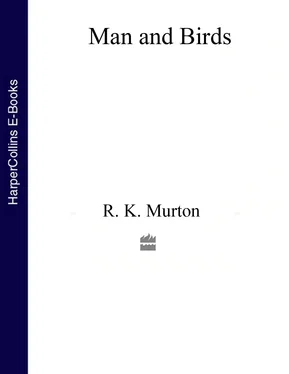Unlike the marsh harrier, the hen harrier has proved remarkably adaptable in its habitat requirements: indeed in the Americas it is the only harrier and occupies the combined niche of all the Old World species. In the north of Britain it has increased, despite fairly heavy persecution, and is doing particularly well in the new conifer plantations of Scotland, which are rich in ground rodents. On the whole, the hen harrier seems to be making good the ground it lost in the nineteenth century, when an even more intensive slaughter banished it from the Scottish mainland as a breeding species. In eastern Europe, the pallid harrier has expanded and increased its range from the Russian Steppes, in close association with the spread of agriculture. Thus human disturbance alone does not necessarily disturb birds of prey. This is shown by the distribution and breeding of the osprey on the eastern end of Long Island Sound in coastal Connecticut and New York with little regard for human activity; it nests on artificial man-made platforms as does the stork in Europe.
The difficulties of measuring the contribution of habitat change and the persecution of gamekeepers, skin and egg-collectors to the decline of the raptors is well illustrated in the case of the buzzard. The changing status of this bird has been very carefully documented by Dr N. W. Moore following a survey sponsored through the British Trust for Ornithology. Until the early nineteenth century the buzzard was to be found over virtually the whole of the British Isles. Then a serious decline occurred in East Anglia, the Midlands and much of Ireland in the mid-nineteenth century, followed by some recovery in the twentieth century. Today densities of 1–2 pairs per square mile can be expected in suitable habitats. The decline cannot be attributed directly to the spread of agriculture during the nineteenth century because the species underwent increases and decreases both during times of agricultural advance and recession. Also during this period the rabbit, one of the main foods of the buzzard, became more common. Similarly, more urbanisation took place between 1915 and 1954 when the buzzard was increasing, than during the years 1800–1915 when it was decreasing. Furthermore, in the 1954 survey, which indicated a British population of 20–30,000 birds, the highest buzzard density was recorded on mixed agricultural moorland, rather than in pure forest or on extensive moorland, where nesting sites seem to be in short supply. In fact, Moore attributes the early decline of the buzzard to the game-preservation which boomed from 1800–1914. Convincing evidence is provided by his maps, which show an inverse correlation between areas of intensive game-preservation, judged by the number of gamekeepers per square mile, and the distribution of buzzards. His view is also supported by the fact that the biggest recovery took place during the two world wars, when there was much less game-preservation, and many keepers were fighting a different adversary. However, the early decline of the buzzard in the nineteenth century is also temporally related to a marked decline of sheep farming, particularly in East Anglia, and, as discussed below in the case of the raven and carrion crow, the associated loss of carrion may have provided the initial cause, being only accelerated by keepers. Nor does persecution account for the disappearance of the buzzard from Ireland.
Myxomatosis was confirmed at Edenbridge in October 1953, and from two original outbreaks it rapidly spread until by early 1955 rabbits throughout the mainland of Britain were infected with a 99% lethal strain of the virus (Armour and Thompson 1955). The 1954 buzzard survey was carried out before there had been widespread reductions in rabbit numbers, but already many poultry farmers and shooting men were afraid that the bird would now turn to other forms of prey, particularly chickens and game-birds. The same concern was accorded the fox, but fortunately an investigation of this animal’s feeding habits had been made before myxomatosis by Southern and Watson (1941) and this was repeated by Lever (1959) on behalf of the Ministry of Agriculture in 1955. The results showed that in the absence of rabbits, foxes concentrated on other small rodents which would normally have been their second most important prey; the incidence of poultry or game-birds in stomach remains did not increase. This turned out to be roughly what happened in the case of the buzzards. Deprived of rabbits, they turned to other small rodents, but took no more game-birds or poultry than before. In the normal course of events the buzzard is not a very specialised feeder and takes a wide range of prey, including rabbits, small rodents, birds and invertebrates, so that their response to a density change in one prey species was as discussed above (see here). Although the buzzard could turn to other prey, it proved much more difficult for the birds to obtain enough food. The immediate consequence of myxomatosis was that many pairs failed to breed, while those that did attempt to nest laid fewer eggs and were much less successful than usual at rearing the young.
The deforestation in north-west Scotland which caused the loss of the roe deer, great-spotted woodpecker and other species (see here), also opened up the Western Highlands for sheep grazing (around 1800); at first good on the rich woodland soil, but subsequently poor as a result of soil degeneration and moor burning. Muirburn resulted in the loss of woody, nourishing and palatable plants leaving only those species resistant to fire. Associated with this spoliation of the habitat, the numbers of all local animals decreased, including grouse, mountain hares, woodcock, snipe and red deer. These last die in large numbers in winter because the impoverished habitat provides much too poor a food supply at the critical time – ideally, good management should ensure a better balance between summer and winter resources. For roughly the same reasons, many sheep die each winter and few lambs survive. A good deal of carrion therefore exists in the form of deer, lambs and ewes already doomed to die and this provides food for golden eagles in the area. Dr J. D. Lockie, who has examined the problem in detail in Wester Ross, has taken great care to discover to what extent eagles prey upon live sheep. Lambs taken as carrion have often lost their eyes as a result of crow attack, or have had limbs or ears bitten off by foxes. In catching live lambs the eagle’s talons cause considerable haemorrhage and bruising of the back, which can be recognised at a post-mortem. It is, therefore, fairly easy to distinguish the two sorts of prey by examining lamb carcases in eyries, and for 22 remains found at one eyrie between 1956 and 1961, 10 could be so categorised. Three of these lambs had been killed by eagles and seven taken as carrion. What could not be determined was how many of the live captures were weakling animals or twins – an important consideration in the case of attacks by ravens and carrion crows (see below). Nevertheless, the anti-eagle policy adopted by so many shepherds is understandable. Lockie was able to show that the percentage of lamb in the eagle’s diet averaged about 46% in years when lamb survival was average or poor, that is, when conditions for lamb rearing were poor; but it fell to 23% in years of high lamb survival. Hence, when lamb was not abundant the eagles compensated by turning to other prey. Clearly, sensible sheep management is the answer to any eagle problems, and it is not fair to attribute poor lamb seasons directly to eagle predation.
On the Isle of Lewis, complaints that eagles had been attacking sheep in 1954 were investigated by Lockie and Stephen on behalf of the Nature Conservancy. Here the main prey comprises rabbits, lamb and sheep carrion, supplemented by a few hares, grouse, rats, golden plover and hooded crows. Occasionally the eagles do attack live lambs and a pair which were seen to attack 5 lambs sparked off the complaints. Actually, out of thirteen local farmers and crofters interviewed, only two had seen eagles in the act of killing lambs, though two others believed that eagles did attack lambs. The eagle has increased on Lewis since about 1946, coincident with a decline in mountain hares, grouse and rabbits, but an increase in sheep. As the eagle density is now, if anything, higher on Lewis than in other areas of Scotland, where a much richer wild fauna exists, it seems that the high density is maintained by the sheep carrion, of which there is an excessive amount because sheep mortality is high. Overgrazing occurs and deficiency diseases are frequent. In one two-mile walk on 20 April, 28 carcases were counted. Again the basic problem is one of land management, the inefficient farmer being the one who suffers most.
Читать дальше












